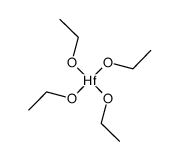13428-80-3
| Name | ethanolate,hafnium(4+) |
|---|---|
| Synonyms |
hafnium ethoxide
Hafnium tetraethoxide Tetraethoxyhafnium MFCD00070459 |
| Boiling Point | 180-200ºC 13mm |
|---|---|
| Melting Point | 178-180ºC |
| Molecular Formula | C8H20HfO4 |
| Molecular Weight | 358.73200 |
| Flash Point | 8.9ºC |
| Exact Mass | 360.08300 |
| PSA | 36.92000 |
| LogP | 1.94880 |
| Appearance | crystal | white to off-white |
| Vapour Pressure | 82.8mmHg at 25°C |
| Water Solubility | It is soluble in hydrocarbons, reacts with ketones, esters. Reacts exothermally with water |
|
Section 1: Product Identification Chemical Name:Hafnium (IV) ethoxide, 99% CAS Registry Number:13428-80-3 Formula:Hf4O(OC2H5)14.2C2H5OH EINECS Number: Chemical Family:metal alkoxide Synonym:hafnium ethanolate. ethanol, hafnium salt.
Section 2: Composition and Information on Ingredients IngredientCAS NumberPercentACGIH (TWA)OSHA (PEL) Title Compound13428-80-3100%0.5mg/m3 (as Hf)0.5mg/m3 (as Hf) Section 3: Hazards Identification Emergency Overview:Irritating to the respiratory tract, skin and eyes. May be harmful if swallowed. Primary Routes of Exposure:Inhalation, ingestion, contact with skin and eyes. Eye Contact:Causes slight to mild irritation of the eyes. Skin Contact:Causes slight to mild irritation of the skin. Inhalation:Irritating to skin, eyes and respiratory tract. Ingestion:Ingestion may cause gastrointestinal distress, nausea, vomiting and headache. Acute Health Affects:Irritating to skin, eyes and respiratory tract. No data is available for this product. Prolonged exposure to ethanol vapors may be harmful to nerves and Chronic Health Affects: liver. NTP:No IARC:No OSHA:No SECTION 4: First Aid Measures Immediately flush the eyes with copious amounts of water for at least 10-15 minutes. A victim may need Eye Exposure: assistance in keeping their eye lids open. Get immediate medical attention. Wash the affected area with soap and water. Remove contaminated clothes if necessary. Seek medical Skin Exposure: assistance if irritation persists. Remove the victim to fresh air. Closely monitor the victim for signs of respiratory problems, such as difficulty Inhalation: in breathing, coughing, wheezing, or pain. In such cases seek immediate medical assistance. Ingestion:Seek medical attention immediately. Keep the victim calm. Give the victim water (only if conscious). SECTION 5: Fire Fighting Measures Flash Point:not applicable Autoignition Temperature:no data Explosion Limits:no data Extinguishing Medium:carbon dioxide, dry powder or foam If involved in a fire, fire fighters should be equipped with a NIOSH approved positive pressure self-contained Special Fire Fighting Procedures: breathing apparatus and full protective clothing. Hazardous Combustion andIf involved in a fire this material may emit toxic organic fumes. Decomposion Products: Unusual Fire or Explosion Hazards: No unusual fire or explosion hazards. SECTION 6: Accidental Release Measures Avoid contact with water. Small spills may be adsorbed into diatomaceous earth, sand, or other suitable Spill and Leak Procedures: adsorbent, and swept up. SECTION 7: Handling and Storage Store in a tightly sealed container in a dry place. If container is left open, product may adsorb moisture and Handling and Storage: carbon dioxide from the atmosphere and release ethanol vapor. SECTION 8: Exposure Controls and Personal Protection Eye Protection:Always wear approved safety glasses when handling a chemical substance in the laboratory. Skin Protection:Wear protective clothing and gloves. Ventilation:Material may form a vapor upon exposure to air. if possible, handle the material in an efficient fume hood. If ventilation is not available a respirator should be worn. The use of respirators requires a Respirator Respirator: Protection Program to be in compliance with 29 CFR 1910.134. Ventilation:Material may form a vapor upon exposure to air. if possible, handle the material in an efficient fume hood. Additional Protection:No additional protection required. SECTION 9: Physical and Chemical Properties Color and Form:white to off-white xtl. Molecular Weight:358.73 Melting Point:no data Boiling Point:no data Vapor Pressure:no data Specific Gravity:no data Odor:alcohol-like odor Solubility in Water:Reacts with water SECTION 10: Stability and Reactivity Stability:air and moisture sensitive solid Hazardous Polymerization:no hazardous polymerization Conditions to Avoid:contact with moisture Incompatibility:Oxidizing agents and halogens Decomposition Products:Carbon dioxide, carbon monoxide, organic vapors, and metal oxides and carbonates. SECTION 11: Toxicological Information RTECS Data:No information available in the RTECS files. Carcinogenic Effects:No data available Mutagenic Effects:No data available Tetratogenic Effects:No data available SECTION 12: Ecological Information Ecological Information:No information available SECTION 13: Disposal Considerations Disposal:Dispose of according to local, state and federal regulations. SECTION 14: Transportation Shipping Name (CFR):Non-hazardous Hazard Class (CFR):NA Additional Hazard Class (CFR):NA Packaging Group (CFR):NA UN ID Number (CFR):NA Shipping Name (IATA):Non-hazardous Hazard Class (IATA):NA Additional Hazard Class (IATA):NA Packaging Group (IATA):NA UN ID Number (IATA):NA SECTION 15: Regulatory Information TSCA:Not listed in the TSCA inventory. SARA (Title 313):Title compound not listed. Second Ingredient:none SECTION 16 - ADDITIONAL INFORMATION N/A |
| Hazard Codes | F+ |
|---|---|
| Risk Phrases | 36/37/38 |
| Safety Phrases | 26-36/37/39 |
| RIDADR | UN3180 |
| Packaging Group | II |
| Hazard Class | 4.1 |
